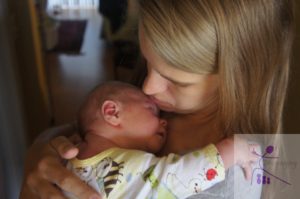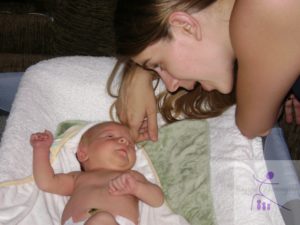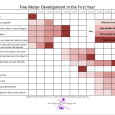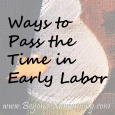The concept of “attachment” when referring to relationships and child development goes way beyond the parenting method (and has been around way longer!) While the methods of Attachment Parenting aim to build a positive relationship and healthy attachment, they are many ways to nurture healthy attachment.
So what exactly is “Attachment”?
 “Attachment” is really just a fancy, technical term for “bonding”. Attachment is part of the Social/Emotional area of child development and refers to the bond between a child and parent (or caregiver, sibling, grandparent, etc). Attachment in children begins developing immediately as babies learn who will care for them and comfort them. Typical children will easily build an attachment with those around them if they are consistently in an environment where their basic needs are met and they feel safe.
“Attachment” is really just a fancy, technical term for “bonding”. Attachment is part of the Social/Emotional area of child development and refers to the bond between a child and parent (or caregiver, sibling, grandparent, etc). Attachment in children begins developing immediately as babies learn who will care for them and comfort them. Typical children will easily build an attachment with those around them if they are consistently in an environment where their basic needs are met and they feel safe.
Mary Salter Ainsworth was a developmental psychologist who extensively studied early attachment and described three types of attachment in children:
- Secure: Children use their parents as a “safe place” and freely explore their environment while maintaining interaction. Secure children get distressed when their parents leave but are easily calmed down when the parent returns.
- Avoidant: Children are described as distant from their caregivers, a lack of eye contact and avoiding contact after separation. Parents are not their secure base and are often seen as independent
- Ambivalent or Resistant: Children can become distressed by separation yet distance themselves when the parents return and are often not calmed by their parents’ attempts to console them. They exhibit less positive communication such as smiling, and might seek closeness by being angry or hostile.
Why is developing Secure Attachment so important?
Babies whose needs are attended to lovingly, promptly and consistently are likely to develop a secure relationship with the people who care for them. Babies learn they can rely on their caregivers to meet their needs and this understanding encourage the child to communicate through crying, facial expressions and grunts at first and later through gestures and eventually speaking. Feeling secure in their relationships with caregivers helps babies develop confidence to explore and interact with others.
People who develop secure attachments as babies develop into children who are independent, show compassion for others, and generally play well with others. They are generally confident, adapt well to new environments, are able to create positive relationships with others and easily follow directions as they grow older. This is not just due to the early attachment of baby to caregiver but also from the continued support and love received from caregivers and develop the ability to trust others and develop new, healthy relationships in the future (of course, the opposite could occur as well: when parents are not responsive to a baby, they might continue to be distant as the child grows and the child may see people as untrustworthy).
How can you build a secure attachment with your child?
The most important thing you can do to build a strong attachment is to be attentive to your child’s needs. This doesn’t mean you need to follow the methods of “attachment parenting” by baby-wearing, breastfeeding on demand or co-sleeping (those these are all wonderfully great things if they fit your life and preferences). All it means is you need to listen to your baby and respond to their cues and feed them when they’re hungry, change them when they’re dirty, help them sleep when they are tired, and hold, love and cuddle them when you both need it.

This affection sharing is so important. The holding, snuggling, rubbing, kissing, gazing, tickling, talking and engaging our babies is what teaches them about love and security which helps children to become trusting and seek future positive relationships.
Keep interactions two-sided by following your baby’s lead. Pay attention to when the baby wants love and cuddles and when they want to freely explore. Note what the baby is interested in and talk about it (this is also great for language development!) When the baby smiles, coos, laughs or babbles, engage them by returning the action and prolonging the moment.
Most babies easily build secure attachments with those who primarily care for them but there are times when a baby has trouble bonding with others. This can be due to the type of caregiving the child receives or a developmental issue.
What are the red flags indicating a lack of secure attachment?
- An infant who shows no attachment, does not seek comfort when upset or who is easily comforted by any adult.
- A child who doesn’t freely explore their environment and remains close to their caregiver at all times or a child who is reckless in their explorations and ignores their caregiver.
- A child who doesn’t engage and avoids eye contact, doesn’t smile or reach out to be picked up.
- A baby or child who cries inconsolably and doesn’t respond to attempts to be calmed or soothed or spends a lot of time comforting themselves through rocking or other self-soothing behaviors.
- A child who doesn’t notice or care when you leave them alone, who doesn’t follow you with his/her eyes or try to engage you with cooing or other sounds.
Here are some great resources for more information on attachment:
Child Development: Educating and Working with Children and Adolescents (2nd Edition)
by Teresa M. McDevitt and Jeanne Ellis Ormrod
Extending the Dance in Infant and Toddler Caregiving: Enhancing Attachment and Relationships
by Helen H. Raikes and Carolyn Pope Edwards
Attachment and Reactive Attachment Disorders on Helpguide.org
Mary Ainsworth on Simplypsychology.com







